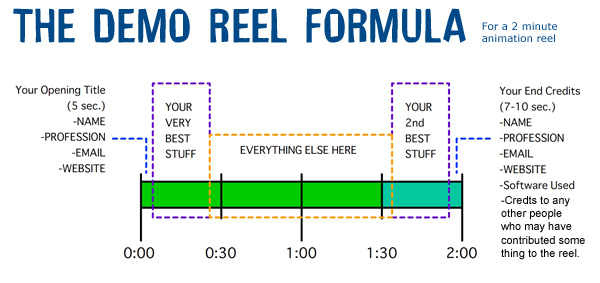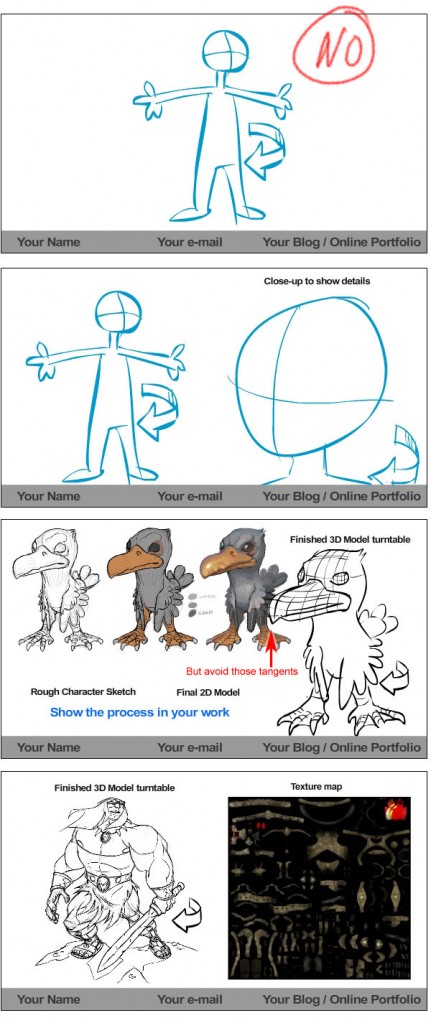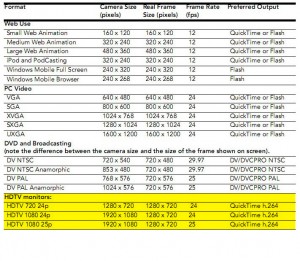Last updated on August 3, 2010
Over the years I’ve had the pleasure of screening hundreds of demo reels. I’ve seen plenty of good ones and bad ones, but even though the format has changed from VHS, to CD, then DVD, and now YouTube, I had always noticed a similar pattern of errors in the editing and assembling of the reels themselves. Now that I’m in the position of offering advise to students in the art of crafting their demo reels, I’ve gained new perspective in the subject. So here’s some suggestions (especially for those making their first) on how to construct a more successful demo reel.
What is the purpose of an animation demo reel?
Whether it’s focus is on special effects, character animation, background art, environment design, or motion graphics, 2D or 3D… it’s goal is always the same; To showcase your skills and get you the job you’re looking for.
To start off, let’s look at the formula you should follow.
A) Content Placement: Put all your best stuff at the start, your second best stuff at the very and, and everything else scattered inbetween. Why? You want to give the viewer a strong impact at the very start to hold their interest and impress them from the very beginning. Then you end it all on a sweet note by finishing it with your 2nd best work.
B) Time: Keep the length of your reel between 1:30 and 2:30 in length. That’s 90-150 seconds. Why? Anything over two minutes begins to feel like overkill. Whether you have 1 year of experience or 10, most employers don’t want to sit through 3+ minutes of video clips that have no connecting story. 95{f2e86ea6af82e2bb048871abf045622abf0ed27fb513932dc1ee8c05a54cbefd} of the time the employer has decided within the first 30 seconds if you are a potential candidate or not. So keep your short films separate from the reel, provide a link to other longer works whether they are entirely your own creations or collaborations with others, and keep your demo reel short and sweet.
C) Titles: Name, Specialty and Contact Information at the head and tail of your reel, you’d be surprised how many reels I’ve seen that did not have this. Also, if possible, have this info as a semi-transparent image/text at the bottom of your screen during the whole reel. Clear and easily readable but not too big as to crop of any of your visuals. Title cards should be up for 3 to 4 seconds, except your final one at the tail end, that one can stay on for a while longer.
–
When crafting your demo reel there’s always four main things to consider.
1- Pacing: How you edit and cut your reel together could mean the difference between a boring, slow-paced reel, or a nice, smooth and exciting reel. Never be afraid of your reel being too short, anything over 1 min. is fine, as long as it only shows your very best stuff. Filling up time with mediocre content only damages your chances of getting the job. Also, make sure you’re not cutting and moving too fast, give a chance for the viewer to take in all the info. Always remember: Quality over Quantity.
2- Style: Find one typeface to use and use only that one through out your reel for titles and contact info. When it comes to displaying 3D models don’t go crazy with all kinds of different background textures that distract from the main centre of attention. Fonts, colors, backdrops, and soundtracks should be kept simple and consistent.
3- Content: This is what it’s all about! Take a lot of time to narrow down only the very best clips you’ve completed to stack into your reel. Ask friends/co-workers/classmates to watch your shots and tests to determine which ones showcase your skills best in Story, Character, Physicality, Acting, and Entertainment Value.
4- Music: Keep it simple and non-abrasive, the soundtrack should never draw attention to itself. If your reel has lots of lip sync tests or cuts from shows/films you’ve worked on with dialogue, then leave out the music entirely. Unless of course you dedicate a portion of your reel to possibly just design or modeling, then a bit of jazz wouldn’t hurt. Some directors and producers actually prefer no music at all, I tend to disagree as sometimes it can add a lot to the mood of the entire piece. Some directors turn off the sound entirely (unless there’s lip sync/dialogue involved), so your choice of music doesn’t matter much, as long as it is not distracting or abrasive to your visuals.
When it comes to your first reel (perhaps near the end of your college animation program) there are a couple things to consider:
1) If you have little to no production experience, you are a recent graduate seeking your first project in the industry, you must impress your potential employer, this is the whole purpose of your demo reel. Don’t beat yourself over the fact your stuff isn’t as good as the pros you admire online. Focus on your strengths and display only your strengths.
2) If you are a student about to graduate; professionalism, versatility, and resourcefulness are the qualities you want to show with the clips and images you’re displaying. Most likely you only have classroom exercises and personal projects to showcase, stay confident, cut out any elements that may expose your weaknesses, and study the massive amounts of kick-ass reels online to get a sense of what works and what doesn’t.
The “look” of your reel.
Why should you be concerned over the overall layout and compositional structure of your reel? It shows the employers your willingness to go the extra mile and treat this reel as a nice little movie with a start, middle and end. You can spend countless hours re-arranging your clips in an attempt to create a nice flow from one shot to the next, and that’s a good thing, the end result will show your efforts. If your subject placement and your camera moves are even a bit distracting or over-done, then you instantly leave a bad impression. Work on making smooth and subtle camera moves that show case your environments and set designs or background art. With human-like character you’ve got a tall vertical shape with lots of dead space on the sides when you keep it centered, so avoid the middle! You can have a walk cycle looping on one side of the frame and display the character rig on the other.
–
For 2D stuff, generally you see blogs having samples of model sheets and poses for character design work. For 3DCG artists you display your character models on turntables, cross-fading the wireframe with the shaded versions, etc. With the advent of HD demo reels, having a wide screen format for your 3D reels often creates more wide open space around the characters you are displaying, whether its a run cycle or just a 360-turn-around, all this negative space can look unappealing. This creates an inefficient use of space by centering the often very vertical figure. To remedy this, always try to fill up some dead space with other views or elements of the subject. For 3D models, you can have the figure on the turntable while you display close-ups or the texture map on the other side of the frame.
When choosing your typeface, go with something simple, Arial Bold isn’t a bad choice, or any one of these.
Let’s take a look at some examples.
Observe the 3D demo reel of recent animation college graduate André Boudreau:
http://vimeo.com/9899376
3D Maya Generalist is what he is selling himself as, tracking, compositing, modeling, animation, texturing/shading, lighting, environments/sets and character designs are displayed. The speed, pacing, audio, camera work, editing, and framing is simple and smooth. Therefore his reel appears professional, versatile, and shows its maker is resourceful and knowledgeable for an entry level position as a 3D-CG artist.
Take a look at Wes Kandel’s Visual Effects Demo Reel:
http://vimeo.com/7159058
The music does not draw attention to itself, it does not distract, but rather it compliments the well paced out visuals. A high level of design is present in his style, he definately focuses on nothing but his strengths.
Marvel at the work behind this film by Gobelins students:
http://www.le-building.com/makingof.htm
This isn’t a demo reel, but it has all the same properties. The Quicktimes presented here show a variety of design and animation processes both for the 2D and 3D elements of the short film. Displaying how the character and prop rigs operate and the layers of production placed in the film are a great inspiration of how you could layout your own reel.
Examine Mirco Chen’s Demo Reel:
http://www.youtube.com/watch?v=PD8IWu1kac8
This is a nice example of versatility in a show reel. A unique assortment of graphic styles, timing, velocity, pencil tests, symbols-based animation, traditional frame-by-frame Flash animation, some designs and FX displayed with a nice blend of humor, acting, and performances showcased.
Study the Character Animation Reel of Trevor Hsieh:
http://erikleeanimation.sslpowered.com/trevorhsieh/index.html
Here’s a clinic in simplicity. Only 6 clips totaling only a minute of footage, showcasing one thing; His skills in 3D character acting. Short, simple, and to the point.
Here’s a nice 3D Modeling Reel by Ruben Matrinez:
http://vimeo.com/11797682
Artful, stylish, nice typography, good color sense, and lighting that compliments the subject matter instead of distracting from it. Lots of attention to detail that makes it a very professional looking piece.
Observe Matt Sheppard’s Character Animation Reel:
http://vimeo.com/10986002
The brilliant part of this is that only 10 seconds of the 140 second reel is production work, with a dab of 3D to show how he’s been teaching himself that aspect also, the rest is all personal work! Directors LOVE to see this. It shows self-motivation, creativity, initiative, and storytelling skills that many directors and studio heads are looking for.
There’s plenty more samples all over the internets, like here.
Whether you are training to be a 3D or 2D animator, or even if you have a couple years of experience, you can absorb tons of inspiration through 11 second club.
You can download past audio clips and animate your character to your favorite dialogue track. When you have the time, watch the eCritiques from big-name industry professionals, most of them have a lot of profound advice on timing, motion and acting for each month’s winning entry. Many professional animators and animation students use this as a way to stay creative or as a great opportunity to practice and learn more about character acting. Even if you cannot meet the monthly deadlines, keep working at it and it can end up being a great demo reel piece.
When applying for a job as a character animator, your reel is your most important weapon. The resume and portfolio fall by the wayside as this mini-movie is truly your one biggest chance at getting that job. Make certain that your clips collectively showcase all the principles of animation:
Staging – Placement of all your subjects within the frame, presenting an idea so that it is unmistakably clear.
Shape and Form – The scale of the character compared to the others, avoiding tangents & twinning, using the characters mass, size, body language and overall shape as part of its personality.
Squash and Stretch – Defining the rigidity and mass of an object by distorting its shape during an action.
Timing and Motion – Spacing actions to define the weight, size and velocity of objects and the personality of characters.
Anticipation – The smaller preparatory action that precedes a major action, used to show that a character must physically prepare to perform an action or gesture.
Arcs – The visual path of action for natural movement.
Exaggeration – Accentuating the essence of an idea via the design and the action.
Secondary Action – The action of an object resulting from another action.
Follow Through and Overlapping Action – The natural elaboration of an action that shows how one part leads organically to the next until the action is resolved. It can also indicate that not all parts of a character arrive at the same time, and can go past the point of arrival and settle back. Often used to indicate weight, and movements for clothing, hair, etc.
Slow In and Out – The spacing of the in-between frames to achieve subtlety of timing and movement. Accelerating out of a pose – individual frames are spaced progressively farther apart (so the action does not start abruptly), and decelerating into the following pose – spaced progressively closer together (to complete the action with a smooth settling-in).
Solid Poses, Visual Clarity, and Mood – The principles of creating shapes within your poses and compositions; weight, volume solidity and the illusion of three-dimensional form applied to animation as it does to academic drawing for 2D animation. The attitude of the character, facial expression, posture, behaviors, and body language must be readable. The stronger the poses the more appealing the animation will be. This includes an easy to read composition, clear key poses, and personality development that will capture and involve the audience’s interest.
Line and Silhouette – Line of action that runs through the body and how well a pose can read due to the negative space around it.
Action and Reaction – To make the character seem alive it must interact with its environment and other characters.
Direction – Where is the character going? What is it doing? Make definite changes from one attitude to another in timing and expression. Let the body attitude echo the facial. Pay attention to a character’s eye-line, and the character’s poses and behaviors must lead the audience to where they should look within the picture area.
Tension – Providing a good sense of weight and resistance to all things make any action more believable.
Beat and Rhythm – Part of sensible timing is finding a rhythm to the character’s actions.
Straights and Curves – A nice balance of curved and straight lines in a character’s postures and actions must be achieved to compliment the acting intended.
Depth, Volume and Perspective – Avoid a character’s posing and placement in a scene that appears too flat, or motion that appears to mechanical, a character’s volume must be kept consistent. Perspective, foreshortening, angles, and all other considerations in design and motion should be considered as objects and characters are interacting. The physical space that every element on screen inhabits is important.
When applying for a 3D environment modeling job, make certain you display the core fundamentals of visual design in your reel:
– Picture Area / Framing
– Rule of Thirds
– Directional Lines
– Open Space
– Focal Point
– Balance
– Natural Frames
– Contrast / Value
– Lighting
– Depth & Perspective
Similar core values of composition must be displayed in the 2D portfolios of matte painters and BG designers as well. Avoid symmetrical compositions and tangents. Tangents are when two objects (or characters) touch each other at their lines (or merge at their edges) rather than clearly crossing through each other or separated from each other with negative space.
If you are an animation generalist and haven’t specialized in much of anything yet, then show some variety; Flash animation, classical animation, Toonboom, Photoshop-made concept art and/or 3D modeling clips. It’s OK if you only have tests and exercises in traditional animation or Maya, but show ONLY the best stuff.
A one minute reel with good character acting is better than 4 minutes of all the stuff you’ve ever done. For character animation reels – show you can achieve emotions with subtle facial animation and strong acting principles … it’s all in the eyes. For 3D environment modeling reels – show the stages of the set being built, keep the camera moves soft and slow. The same goes for 3D and 2D character designs. Show multiple views/rotations and the stages in which you created the character and props. If possible – show diversity with different design styles, ie: very stylized/cartoony vs. more realistic.
DOs and DON’Ts
-Do make sure all the information on your title cards are correct, check for spelling mistakes and typos, and have friends double check them too.
-Do show your reel to many of your peers, classmates, co-workers before posting it online, get feedback from them, and do appropriate changes. Choose carefully the content of your reel, take your friends’ advice into consideration if they find some parts too repetitive or certain clips unnecessary. Trimming down your reel to a shorter and higher quality piece could increase your chances.
-Don’t do a chronological work history.
-Don’t include work in progress.
-Don’t ask the employer for feedback.
-Don’t include early tests and tutorials.
-Don’t have a slide-show of your life drawings (that’s what your online portfolio blog is for).
More info on Demo Reels can be found all over cyberspace:
http://www.grafixjobs.com/index.php?option=com_content&view=category&layout=blog&id=36&Itemid=70
http://splinedoctors.blogspot.com/2006/01/demo-reel-tips.html
http://www.animationmentor.com/webinar/replay/20080709carlos/carlos1.html
http://www.pixarcanada.com/demo_reel.html
Update your reel every 6-12 months, or after each major contract.
If you have a new project coming up right after, well, you don’t need to update your reel, you’re too busy getting ready for the next production. When you have some downtime or a lengthy break between gigs, take the time to update that reel. Always save all the original source files and project files that you used to construct your reel, so you won’t have to go digging for some old clips all over again. Whether it’s FinalCut Pro, Premiere, iMovie, or whatever the software you use, keep it clean and organized so it makes the process of removing old stuff and adding new stuff in relatively painless.
Vimeo and YouTube seem to be most popular high-resolution options for free online demo reel hosting, it’s easy, fast, and high-definition compatible. Thanks to programs like Flash and Maya, you can always render at very high resolutions without any problems, and online video sharing sites can accept many types of sizes and formats.
Best formats that YouTube accepts:
* Video Format: H.264, MPEG-2 or MPEG-4 preferred
* Resolution: 640×360 or 853×480 or 1280×720 (16:9 aspect ratio)
* Quality: At least 4000 kb/s
* Audio Format: MP3 or AAC preferred
* Frames per second: 24 (or 23.97)
* Maximum file size: 1 GB
Remember, your employer sees a lot of demo reels, keep it moving, learn to trim and cut your shots tightly. Only do a slide show of artwork if you are tailoring a demo reel to showcase design and paint work for an employer. Fine art, BG color keys, character color models are fine, but a simple blog might showcase these images in a much better and more high resolution format.
If you’re graduating with your animation diploma soon or you have at least a year of solid production experience, hopefully this article has helped you to tackle the demo reel riddle. Whether you are exploring how to put together your first reel or to spice up your old one, don’t forget; short & simple, show only your best clips, camera moves and music should not draw attention to itself, and display clear & legible contact info.
Good luck.
-Ron
Find Ron here.







Awesome post Ron! Thick and gooey with info!
Nicely done Ron. Very good.